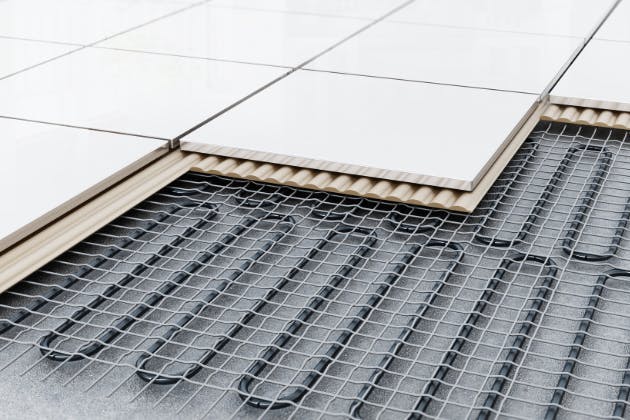For homeowners looking for economical heating options, underfloor heating (UFH) is becoming a more and more popular option. You're not alone if you're thinking about putting underfloor heating in your house but have some doubts. To assist you in making an educated choice, we'll answer some of the most commonly asked concerns concerning underfloor heating here.
Speak to our heating engineers in Dundee, Fife, Edinburgh, and Dunfermline today for underfloor heating installations by calling 07885 982426.

Underfloor Heating FAQs
1. How does underfloor heating work?
Warm water is circulated via a network of pipes or electric heating components that are positioned beneath the floor surface to provide underfloor heating. By distributing heat evenly throughout the space, this radiant heating technique produces a temperature that is both comfortable and steady.
2. Is underfloor heating suitable for all floor types?
The majority of floor materials, including tile, stone, laminate, and engineered wood, may have underfloor heating installed. To optimise effectiveness and performance, it is crucial to confirm that the flooring material of choice is compatible with underfloor heating and that the correct installation techniques are applied.
3. Will underfloor heating increase my energy bills?
Underfloor heating can result in long-term energy savings, even if the initial installation cost may be more than with typical heating systems. Over time, underfloor heating uses less energy and produces cheaper heating costs since it runs at a lower temperature than radiators.
4. How long does it take to install underfloor heating?
The size of the space, the kind of system being installed, and any necessary prep work all affect how long underfloor heating installation takes. Installation can take a few days to a few weeks on average, but depending on your particular project, your installer will give you a more precise time estimate.
5. Can underfloor heating be installed in existing homes?
It is possible to retrofit underfloor heating into existing houses, but it can need some extra work, such as elevating the flooring or installing a thinner system to reduce the rise in floor height. It is advisable to speak with a qualified installer to see whether underfloor heating is feasible and appropriate for your house.
6. Is underfloor heating compatible with renewable energy sources?
Heat pumps and solar thermal systems are two examples of renewable energy sources that work well with underfloor heating. Underfloor heating is an environmentally favourable heating choice for homes that care about the environment. It may be further enhanced in energy efficiency and carbon emissions by combining it with renewable energy.
7. How do I control underfloor heating?
The usual method of controlling underfloor heating systems is using a thermostat, which lets you individually set and modify the temperature you want in each zone or room. Smart thermostats and programmable timers are examples of advanced control solutions that provide extra convenience and energy-saving features.
8. Is underfloor heating suitable for all rooms in the house?
The majority of rooms in a house, including living rooms, bedrooms, bathrooms, and kitchens, may have underfloor heating installed. It might not be appropriate, though, for spaces with heavy floor coverings or permanent furniture that could impede the diffusion of heat.
Underfloor heating in Fife, Dunfermline, Dundee and Edinburgh
We provide underfloor heating installations across Dunfermline, Dundee, Fife, Edinburgh, and the surrounding areas. Get in touch with us today by using our contact form or call us on 07885 982426 and we'll be happy to help.


